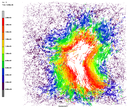Floppy modes and non-affine deformations in random fiber networks
Claus Heussinger and Erwin Frey
Materials as different as granular matter, colloidal suspensions or lithospheric block systems share the common property that they may exist in a highly fragile state. While in principle able to withstand static shear stresses, small changes in the loading conditions may lead to large scale structural rearrangements or even to the complete fluidization of the material. To understand the extraordinary mechanical properties of these systems new concepts have to be developed that go beyond the application of classical elasticity theory and that sufficiently reflect the presence of the microstructure.
In a new article just published in PRL (link below), we focus on a particular class of heterogeneous networks composed of crosslinked fibers. These systems have recently been suggested as model systems for studying the mechanical properties of paper sheets or biological networks of semiflexible polymers. While these networks are known to have a rigidity percolation transition at low densities, we show here that even networks in the high-density regime in many ways resemble the behaviour of fragile matter, despite the fact that they are far away from the percolation threshold. In analogy with the affine theory of rubber elasticity for flexible polymer gels, our approach might very well serve as a second paradigm to understand the elasticity of microstructured materials. In a more general context it may be relevant to topics as different as force transmission in granular media, to the phenomenon of jamming as well as to modelling of lithospheric block systems to improve earthquake prediction schemes.


